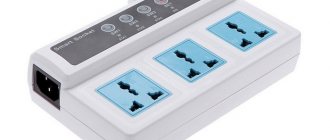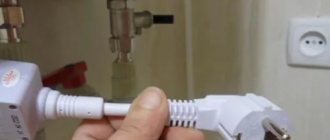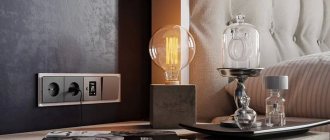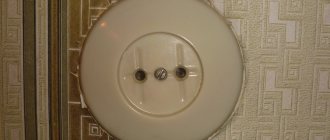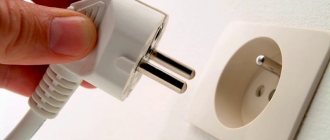A smart Wi-Fi socket is a high-tech device that works independently or is part of the Smart Home equipment. The compact device provides remote control of the power supply of household appliances. To control the outlet, use a smartphone, tablet or other gadget connected to the Internet and equipped with an appropriate application. In addition, the socket can be controlled from a remote control and a mobile phone.
- The need for smart plugs
- Advantages over conventional
- What Wi-Fi devices can do
- How to set up and connect
- Interface for Xiaomi sockets
- How to manage sockets from Yandex
- Features of using other models
- Possibility of synchronization with a smart home
- Main selection criteria
- The best smart plugs: review of 5 models for 2022
- Main disadvantages according to user reviews
- What equipment can replace it?
What is a WiFi socket?
A smart WiFi socket is a special device that is inserted in place of the old socket and connected to the existing wiring. Then the device is used in normal mode. You can connect household appliances and other electrical consumers to it within the established limit.
Control is carried out through an application installed on a smartphone, with which you can remotely turn on and off the power. Some manufacturers offer models with advanced functionality. For example, you can find smart WiFi sockets with a temperature sensor or current consumption data on sale.
In general, it seems that wireless communications are already everywhere, starting from the usual adapters in laptops to a special option for phones called WiFi Calling.
Appearance and varieties
There are two types of sockets:
- External - looks like a block made of high-quality durable plastic. A standard plug is used for input, and a socket is used for output.
- Internal - externally similar to a regular internal socket.
They all have a Wi-Fi module inside that connects to their home router. There is also a smart control system. If the device is expensive, then there may be additional sensors.
They can also be divided by connection type:
- Wi-Fi – connects to the Internet via a router;
- GSM - a SIM card is inserted into it, and control is performed using SMS. Oddly enough, such boxes cost 3 times more.
What does a Wi-Fi outlet look like?
Structurally, WiFi sockets come in two types: overhead and built-in. In the first case, the product looks like an adapter with one connector. The device includes a casing, an indicator, an on/off button and a connector. The built-in model completely replaces the old device in the wall recess.
Unlike conventional products, a WiFi-controlled socket has a more complex design. It integrates a special module that provides remote control via a wireless network. Depending on the type, a display may be installed on the housing to provide additional information.
Terms of use
The smart plug works correctly when using a GSM SIM card. It is necessary to use the device in a room with low humidity, as well as in the absence of metal objects near the equipment, as this will make signal reception much worse. If electrical appliances have a power of more than 1500 W, then when connecting them to the electrical network, it is necessary to ground them in the house. The mains voltage should be 220 V.
The GSM socket is not installed in the following places:
- where medical equipment is located (for example, hospitals or hospitals);
- where cell phones cannot be used;
- with dangerous explosives.
A special feature of the device is that it executes commands that are sent only from a few mobile numbers that are stored in its memory. This prevents unauthorized access.
The disadvantage of the device is the possible lack of a network signal. In this case, the functionality of the device is limited. Therefore, before installing the device, you should make sure that the signal is stable.
Finally, we recommend watching a video that clearly shows how this type of outlet works and which models are the most optimal today:
Now you know what a GSM socket is, what its operating principle is and its scope of application. We hope the information provided was useful to you and helped you decide whether to buy this version of electrical accessories!
We also recommend reading:
- How does a wi-fi socket work?
- Remote lighting control systems
- Connecting the chandelier on the control panel
Why do you need a Wi-Fi socket?
The use of WiFi devices to connect electrical appliances is common in smart homes. With their help you can solve the following problems:
- turn on and off the lights in the room;
- turn on the heater or other appliances before returning home;
- configure the on/off schedule for the device of interest;
- turn on the lights remotely while on vacation;
- connect the iron with the possibility of remote control;
- automatically turn on/off equipment based on a signal from another device (for example, a motion sensor).
The use of a WiFi socket simplifies life and allows you to remotely control electrical receivers over a long distance.
Model differences
Antenna for a computer to strengthen the Wi-Fi signal
Products from different manufacturers differ in design, design features, and functionality. On the Russian market, these devices are represented by models that can be divided into three categories:
- Inexpensive, equipped with a timer with the ability to turn on and off according to time.
- Average price, has a programmable timer, and additionally has a temperature sensor.
- High price, additionally has one or more USB ports for connecting a motion sensor, atmospheric sensor, video camera, and has an autonomous power supply.
How does a WiFi socket work?
The product requires a voltage of 100 to 240 Volts to operate, so it can be used at home or in an office where there is a standard household network. Output power may vary depending on model. This parameter ranges from 2 to 4 kW. This is enough to connect powerful electrical receivers.
The outlet is controlled via WiFi using a smartphone or PC with installed software. To avoid mistakes during use, you must read the instructions (included in the kit). The general connection algorithm is as follows:
- download a special application;
- find a wireless connection in your home, apartment or office;
- enter your password;
- check whether it is enabled or disabled via the app.
The glow of a special LED indicates correct configuration and readiness to perform the assigned tasks. Once you understand how a Wi-Fi outlet works, you can connect household appliances and other equipment to it. In the future, if failures occur, you can reset the settings to factory settings and program the device again.
Device vulnerability
According to recent research, experts have concluded that smart plugs controlled via an app can be hacked. The device address and its password are quite easily captured by hackers, as a result of which the email address is hacked and the initially specified settings and operating schedule of the outlet are changed. The consequences of such actions can be very diverse, from the combustion of household appliances, which leads to a fire, to the break-in of apartments, houses and cottages. The software is quite vulnerable and not yet fully developed, which allows hackers to easily hack the adapters. Owners of smart devices should remember that it is easy to guess the data of sockets without encryption, login and password.
A smart socket, the instructions for which describe in detail the technical characteristics and functionality, is still considered an innovation that is still at the stage of improvement. Such adapters greatly simplify life, while allowing you to protect your home from power surges. Thanks to such devices, you can turn on a coffee maker, electric fireplace, heat food in a multicooker, or turn off household appliances while on a trip. A frequently used device is the Redmond smart socket, which has proven itself to be a reliable adapter that allows you to monitor the status of household appliances that have access to the network.
Smart plug – what is it and what is it for? Why do you need Wi-Fi in a socket at all? How does everything connect and work? I decided to talk about all this in this short article. We will also try to find out whether it is worth buying a smart socket, and what benefits it can have.
Let me start with the fact that Wi-Fi is now being pushed everywhere possible: washing machines, TVs, kettles, multicookers, and even light bulbs. We've already reached the sockets. The concept itself, like the “Smart socket” device, appeared not so long ago. But now many manufacturers have released several models of such sockets. And these sockets are even selling a little.
Let's first find out what kind of device this is. I'll explain in simple words.
- a device that is plugged into a regular outlet (if it is a cover socket, there are simply built-in ones), and other electrical appliances are already connected to it. Like a simple adapter. The socket connects to the home Wi-Fi network. Through a special application for a smartphone or tablet, you can control the outlet. You can turn it off and on from a distance (even via the Internet, far from home). Turn on/off by timer, operation statistics, and even view statistics of electricity consumption of the connected device (only in some models). The functionality depends on the manufacturer and model of the device.
I have experience in setting up and using only smart plugs from TP-Link. This manufacturer has two models: HS100 and HS110. I have already written about them in more detail in separate articles:
There are also other manufacturers. For example, Xiaomi has Mi Smart socket. There is REDMOND SKYPLUG 100S. I'm not even talking about some Chinese, nameless models.
How to choose a Wi-Fi outlet?
The main difficulty for many buyers is choosing the right WiFi device. Experts recommend looking at the following indicators:
- Manufacturer. The products of TP-Link, Sonoff, Broadlink and others are in greatest demand.
- Maximum load power. This parameter determines how many devices can be connected to one WiFi device and not worry about its damage. For a home network, 2.5-3 kW is enough.
- Plug standard. When purchasing from foreign online stores, you need to choose models with a European connection type.
- Functional. Depending on the manufacturer, the number of options may vary. There is an active demand for WiFi sockets with a temperature sensor, the ability to track equipment operating time and electricity consumption, with overload protection and sending SMS about failures. Some devices allow you to set individual scenarios.
- Acceptable degree of protection from moisture and dust. When using the product in a damp room, it will be useful to have curtains. The latter are also necessary to protect children.
An equally important parameter of a Wi-Fi outlet is the price. The indicator directly depends on the manufacturer, power and available functions. The minimum cost is 500-600 rubles. The upper limit is about 12-15 thousand rubles per unit of production. There is one more parameter that needs to be taken into account when choosing a WiFi outlet - reviews. From the comments you can understand how reliable and easy to use the model is, and whether it is worth buying.
Basic safety requirements
In the operating instructions, manufacturers often warn consumers about the dangers of incorrectly using the outlet and even the possibility of accidents. To avoid trouble, the following basic requirements must be observed:
- comply with operating temperature conditions and do not exceed the permissible load in accordance with the technical passport;
- Avoid direct exposure of the device to ultraviolet rays and water;
- Do not place the outlet near powerful heat sources, which can extremely negatively affect the correct operation of the device.
How to use it correctly?
After unpacking the device, you need to connect it. For example, let's look at how to connect the Sonoff model:
- register in the eWeLink cloud and download the application;
- log into the program using your personal data;
- turn on the remote or built-in socket with WiFi control (depending on the model);
- press the button and hold it until the green indicator starts blinking (three times per second);
- On your phone, click “add device”;
- select a WiFi network and enter a password;
- wait until the new device is registered on the server.
For convenience, you can set any name (for example, bedroom, living room, bathroom, etc.).
Installation location of the Wi-Fi router
First of all, choose the correct location for the router. The speed and quality of the signal in remote rooms will largely depend on this.
Those who, in addition to the switchboard, also install a low-current shield, usually place it next to it. In this case, there will be less hassle with connecting and pulling wires.
It is into the low-current panel that the cable from the Internet provider is inserted from the entrance of the house.
For those who do not have such a shield, choose a place in the corridor on the wall in the upper part. The higher the signal, the better the signal.
At the same time, do not forget that there are places where it is strictly forbidden to install a wifi router:
near devices operating at frequencies of 2.4 and 5 GHz (microwaves, cordless phones)
By the way, the 2.4 GHz frequency range is in turn divided into 13 channels.
This is done so that several different gadgets do not interfere with each other when working. At the same time, it is not at all a fact that you will be able to find a completely empty channel, not occupied by neighbors. You will have to look for the most free one in order to avoid future connection breaks and improve the quality of communication.
directly opposite a mirror or cabinet with glass doors
in a deep niche with a metal door
This also applies to low-current shields. Some people place the router in it, along with the rest of the weak point. For example, video surveillance.
Be careful and pay attention to the material from which the shield is made
Features of work
Wi-Fi sockets are easy to use, but require knowledge of some features:
- When the power goes out, the settings are reset. They will have to be installed again.
- The time zone of the device may not coincide with the real state of affairs, so this parameter must be set independently.
- When a power failure occurs, the device automatically turns off.
- If there is no Internet connection, the device does not work. This is due to the fact that all settings are transferred to the server.
On the Internet you can find many instructions on how to make a smart Wi-Fi socket with your own hands. But this makes no sense, because assembling the structure will require knowledge and money. It's easier to buy a ready-made device. It costs a small amount, so you don’t have to skimp on this aspect.
Most common mistakes
The first serious mistake is purchasing a cheap Chinese Wi-Fi socket. The fact is that some manufacturers from this country, despite the fairly decent quality of the product, control the device through an application that provides only one language - Chinese, which, to put it mildly, is not very convenient. Rather, it’s even completely inconvenient. The application for controlling the device must be in a clear language, if not Russian (in most cases), then at least in English. An equally serious mistake is purchasing a functional but bulky device, when connected, two connectors are closed at once.
This makes it impossible to connect any other important household device. But the most important and unpleasant mistake is purchasing a socket that does not meet the required voltage and rated current values. In this case, it will not be possible to connect powerful household appliances to it, which is, in fact, why the Wi-fi device was bought.
Settings
Official resources are confusing with the controls, the TP-Link instructions suggest:
- Plug the electrical appliance into an outlet.
- Control with a single key:
- Hold for 5 seconds – restart.
- Hold for 10 seconds – reset settings.
LED indication meaning:
- Flickering yellow, green – configuration.
- Quick flashes of green – connection established.
- Green light – network found.
- Yellow – reboot.
- Red – the network has disappeared.
- Quick flashes of yellow - factory reset.
The switching center will be a home Wi-Fi router from the company of the same name. It becomes possible to control the system from any point on the globe. If the owner does not think of turning off the outlet powering the router via Wi-Fi.
Selection Arguments
Let us list the selection criteria.
Manufacturer
The vast majority of companies (XiaoMi, TP-Link, D-Link, Sonoff) produce pairable routers. We believe that for Wi-Fi it makes no difference who manufactured the device. TP-Link HS100 or HS110 will work properly with the D-Link router. Take the trouble to configure the hardware correctly by choosing the following:
- channel;
- IEEE protocol version 11;
- radio wave range.
Power
Electrical appliances consume a certain amount of kW. The energy heats up the copper wire, so the equipment is characterized by maximum power. Choose an outlet, ensuring that it clearly covers the ratings of household appliances.
Electrical interface
American and British variants are widely found. Carefully weed out varieties that are alien to Russian realities.

